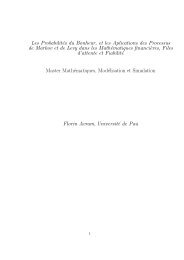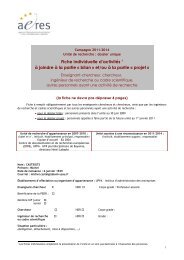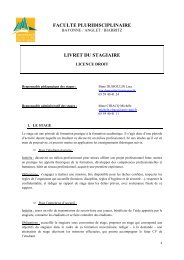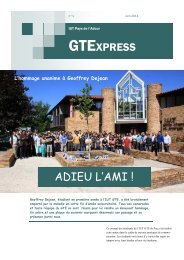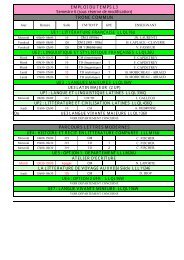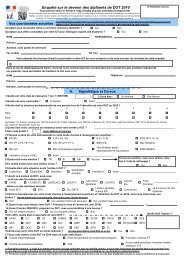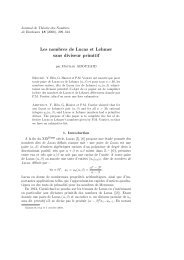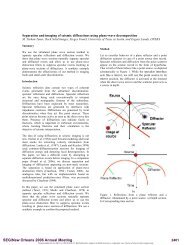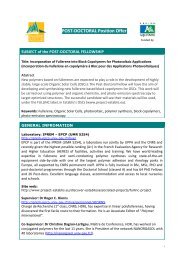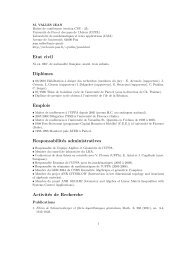Processus de Markov, de Levy, Files d'attente, Actuariat et Fiabilité ...
Processus de Markov, de Levy, Files d'attente, Actuariat et Fiabilité ...
Processus de Markov, de Levy, Files d'attente, Actuariat et Fiabilité ...
You also want an ePaper? Increase the reach of your titles
YUMPU automatically turns print PDFs into web optimized ePapers that Google loves.
FILES D’ATTENTE, FIABILITÉ, ACTUARIAT<br />
Solving the IDE (??) in this case may be achieved either by either<br />
– Inverting the Laplace transform (4.15) by partial fractions :<br />
ψ ∗ (s) =<br />
=<br />
∫ ∞<br />
0<br />
s+µ<br />
e −su ψ(u)du = cψ(0) − λ 1<br />
s(c −<br />
λ ) s+µ<br />
=<br />
sψ(0) + ψ(0)µ − λ/c<br />
s(s + µ − λ/c)<br />
A<br />
s + µ − λ/c + B s ⇐⇒ ψ(x) = Ae−x(µ−λ/c) + B<br />
Note that the n<strong>et</strong> profit condition µ − λ/c > 0 and ψ(∞) = 0 imply B = 0. Thus, s<br />
must simplify in the fraction above and therefore the relation<br />
ψ(0) = λµ−1<br />
c<br />
= λEC 1<br />
c<br />
must hold. This relation turns out to be true for the Cramer Lundberg mo<strong>de</strong>l with<br />
arbitrary claims distribution having finite mean!<br />
L<strong>et</strong>ting l = c − λEC 1 <strong>de</strong>note the ”loading per time unit”, we conclu<strong>de</strong> that ψ(0) and<br />
ψ(0) are proportional respectively to the expected payments and loading per time<br />
unit.<br />
– Solving the Sturm-Liouville IDE equation (4.7) by reducing it to a ODE with constant<br />
coefficients and then looking for combinations of exponentials (or ”looking directly”)<br />
– by probabilistic approaches like the general ”lad<strong>de</strong>r <strong>de</strong>composition” for the Cramer<br />
Lundberg process due to Dubordieu(1952)-Benes(1957)-Kendall(1957) (4.21) or martingale<br />
stopping -see below.<br />
Notes : 1) Replacing the initial risk process (4.1) by one with exponential claims and<br />
i<strong>de</strong>ntical first three moments, and applying the simple exponential claims formula (4.10)<br />
yields the ”simple DeVyl<strong>de</strong>r approximation” in terms of the first three moments of the claims<br />
distribution. This was slightly exten<strong>de</strong>d by Ramsay (?) Ram92 using mixed exponential claims of<br />
or<strong>de</strong>r two; the result however is not that simple anymore, due to the complicated moment<br />
matching and of the <strong>de</strong>pen<strong>de</strong>nce of the Cramer-Lundberg roots r i on the moments.<br />
2) For Gamma claims with shape param<strong>et</strong>er α < 1,, the ultimate and killed ruin probabilities<br />
are also explicit (due to Thorin), though rather complicated – see Gran<strong>de</strong>ll & Segerdahl<br />
GS<br />
(?).<br />
Exemple 4.6.2 L<strong>et</strong> us estimate now the eventual ruin probabilities by a Bayesian approach,<br />
assuming an exponential distribution with uncertain param<strong>et</strong>er µ, which has a prior Gamma<br />
distribution Γ α,β (dµ).<br />
After n observations ⃗ C = (C 1 , ..., C n ), the posterior <strong>de</strong>nsity of µ, f(µ|⃗c) is<br />
Γ α+n,β+Sn (dµ),<br />
where S n = ∑ n<br />
i=1 c i, and the Bayes estimates of µ and m = µ −1 are :<br />
∫<br />
ˆµ n = µf(µ| C)dµ ⃗ = n + α<br />
S n + β ,<br />
∫<br />
ˆm n = µ −1 f(µ| C)dµ ⃗ = S n + β<br />
α + n − 1 .



